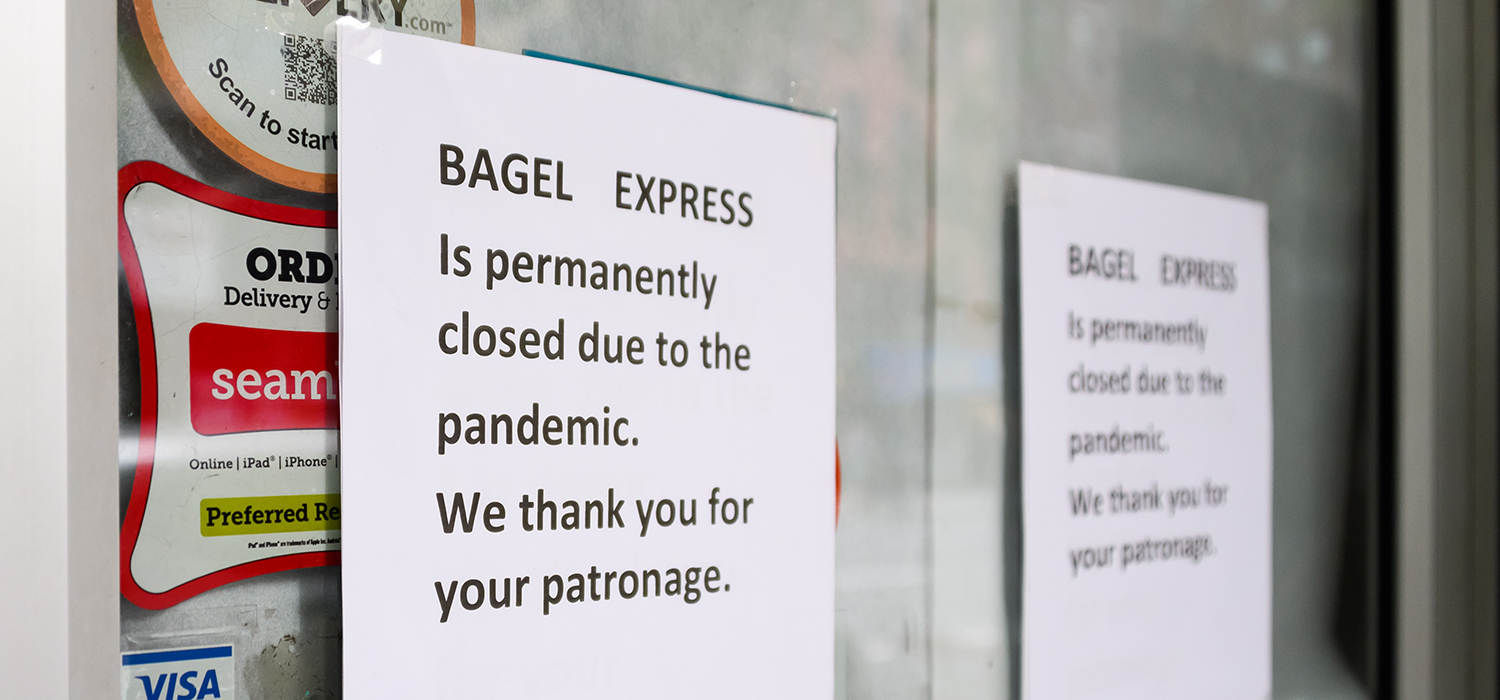
<p>A sign posted outside Bagel Express announces that it is permanently closed during Phase 4 of reopening following restrictions imposed to slow the spread of COVID-19. September 7, 2020 in New York City.(Photo by Noam Galai/Getty Images)</p>
In the second quarter of 2020, gross domestic product (GDP) dropped relative to levels from the previous year in all 50 states and the District of Columbia. Amid a national economic recession, that’s unsurprising, and we’ve previously discussed what this recession means for leisure and hospitality industry workers and government employees.
But new state GDP data for April through June expose how the unique vulnerabilities of certain industries and workers have affected economic output in unprecedented ways and emphasize just how difficult recovery will be.
The recession is nationwide, but its severity varies significantly across the states
All states experienced decreases in GDP between the second quarters of 2019 and 2020, but the declines were not equal, ranging from 4.6 percent in Utah to 14.0 percent in Hawaii. Four states recorded year-over-year losses of “only” 6 percent or less, and five states reported losses of at least 12 percent.
Overall, 17 states experienced double-digit declines, a significant increase compared to the Great Recession, when only two states (Michigan and Wyoming) ever experienced a double-digit, year-over-year decline in quarterly GDP. This variance across states reflects numerous factors, including COVID-19 caseloads, various industries’ relative importance to state economies, and public- and private-sector responses to the pandemic.

The pandemic has hit accommodation and food services particularly hard
On March 19, California Governor Gavin Newsom became the first of 43 governors to implement a statewide shelter-in-place order, though the strictness and duration of executive orders varied. All industries had to adapt to the new public health measures, but restaurants and other services that depend on in-person interactions were particularly affected. Although some businesses adapted with expanded takeout, outdoor service, and curbside pickup, many lost substantial revenues or were even forced to permanently shut their doors.
The impacts of these challenges are plainly visible in state-level data. In Hawaii, the accommodation and food services sector accounted for 8.5 percent of GDP in the first quarter of 2020. In the second quarter of 2020, that sector’s contribution to the state’s GDP was 61 percent lower than it was in the second quarter of 2019. In other words, the sector’s total output generated for the quarter is less than half of what it was a year ago.

Similarly, New York’s accommodation and food services sector reported a year-over-year loss of nearly 70 percent. the highest in the nation. As a result, New York’s total GDP in the second quarter of 2020 was down nearly 12 percent. Although the state’s restaurants are now able to resume indoor dining, they will have to recoup losses over several months of temporary closings, assuming they managed to stay afloat this long. Yelp estimated in August that nearly 1,000 restaurants in New York City alone had permanently closed over the course of the pandemic.
Consumer spending in the accommodation and food services sector declines during all recessions as necessary purchases take increased precedence over restaurant meals and vacations. But states’ mandated closures and reduced services have led the industry’s current decline to depths we’ve never seen before. Hawaii’s year-over-year declines in accommodation and food services GDP at the peak of the Great Recession never fell more than 18 percent, and New York’s never fell more than 9 percent.
These declines are not just bad news for state and local economic growth. They also severely hurt the substantial workforce employed in this sector, which disproportionately comprises women and people of color.
The future of accommodation and food service businesses
As the pandemic rages on, some regions of the country are experiencing new surges, prompting lawmakers to announce reversals of reopenings. And as the weather cools, struggling restaurants and bars will be forced to seek increasingly creative ways to offer socially distanced dining experiences for their customers.
In the initial policy response to the coronavirus pandemic, policymakers took swift steps to ease the economic pain wrought on workers and families, offering emergency cash payments through stimulus checks and expanded unemployment insurance benefits.
But neither of these policies did much to support businesses and the economy as a whole through the crisis. Although some businesses benefited from loans provided by the Paycheck Protection Program, the loans merely enabled recipients to meet their short-term obligations. Unlike other proposals, the program did not facilitate long-term strategies designed for industries whose operations will be affected by the pandemic for the foreseeable future. As one restaurant proprietor recently testified (PDF) to Congress, “We need a cognizant plan or support to survive this pandemic.… We cannot survive without your help.”
However, the passage of a new and timely stimulus bill appears unlikely, leaving the accommodation and food services sector in a bind. And ultimately, true recovery will require effective management of the economic crisis’s underlying infectious disease. Public health guidance requires careful consideration of risks and benefits for consumers and workers in restaurants, bars, hotels, and other indoor recreation spaces.
As long as COVID-19 cases continue to increase across states, recovery in this sector will be anything but straightforward.
Let’s build a future where everyone, everywhere has the opportunity and power to thrive
Urban is more determined than ever to partner with changemakers to unlock opportunities that give people across the country a fair shot at reaching their fullest potential. Invest in Urban to power this type of work.